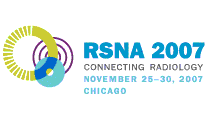
Abstract Archives of the RSNA, 2007
LL-PH6113-B03
Advanced Automatic Exposure Control Based on Contrast-to-Noise Ratio at Multidetector CT: Subjective Evaluation of Radiologist's Lesion Detectability versus Contrast-to-Noise Ratio
Scientific Posters
Presented on November 25, 2007
Presented as part of LL-PH-B: Physics - CT
Yoshiaki Sugaya MS, Presenter: Nothing to Disclose
Taiga Goto, Abstract Co-Author: Nothing to Disclose
Osamu Miyazaki, Abstract Co-Author: Employee, Hitachi, Ltd
Yoshonori Funama PhD, Abstract Co-Author: Nothing to Disclose
Kazuo Awai MD, Abstract Co-Author: Nothing to Disclose
Yasuyuki Yamashita MD, Abstract Co-Author: Nothing to Disclose
Koichi Hirokawa, Abstract Co-Author: Nothing to Disclose
et al, Abstract Co-Author: Nothing to Disclose
et al, Abstract Co-Author: Nothing to Disclose
We have developed an advanced automatic exposure control (ad-AEC) technique that automatically controls the exposure levels based on contrast-to-noise ratio (CNR) of CT images to reduce the radiation dose. It is crucial for ad-AEC to determine the radiologist's image quality requirements so that the detectability of lesions is not compromised. Thus, the purpose of this study was to assess the relationship between lesion detectability and CNR. We also compared the radiation dose reduction of the ad-AEC with conventional AEC (c-AEC), which controls exposure levels based on image noise.
We generated computer-simulated CT images containing 4 different lesion sizes (3.5, 5, 10, and 15mm) and 8 CNRs for each size. Five board-certified radiologists independently evaluated the generated images and rated the presence or absence of lesions with continuous rating scale. We analyzed the results using receiver-operating characteristics (ROC). In addition, we investigated the effectiveness of dose reduction with the c-AEC and ad-AEC by using the computer-simulated liver phantom sized 350 x 210mm. This phantom included contrast-enhanced lesion (liver-iodine compound) (5; 10; and 15mm). We assumed contrast of lesion to be 15 HU at 120 kVp. Though the CNR was set to 1.5 in case of c-AEC, the definite CNR in case of ad-AEC was determined for each lesion size.
The definite CNR required ensuring the presence of 3.5, 5, 10, and 15mm lesions on computer-simulated CT images were 2.98, 1.71, 0.80, and 0.45, respectively. In case of 5mm lesion, the radiation dose of ad-AEC needs to be 30.3% more than that of c-AEC for maintaining the lesion detectability. On the other hand, in case of 10 and 15mm lesion, the radiation dose of ad-AEC compared to c-AEC can be reduced as much as 71.2% and 89.4%, respectively, without degrading the lesion detectability.
The definite CNRs required for detecting lesion sizes were analyzed by ROC study. Our results showed that the ad-AEC could achieve significant dose reduction while preserving image quality.
The new concept of dose modulation based on CNR achieves dose reduction while maintaining optimal image quality for detecting lesion at multidetector CT.
Sugaya, Y,
Goto, T,
Miyazaki, O,
Funama, Y,
Awai, K,
Yamashita, Y,
Hirokawa, K,
et al, ,
et al, ,
Advanced Automatic Exposure Control Based on Contrast-to-Noise Ratio at Multidetector CT: Subjective Evaluation of Radiologist's Lesion Detectability versus Contrast-to-Noise Ratio. Radiological Society of North America 2007 Scientific Assembly and Annual Meeting, November 25 - November 30, 2007 ,Chicago IL.
http://archive.rsna.org/2007/5004872.html

